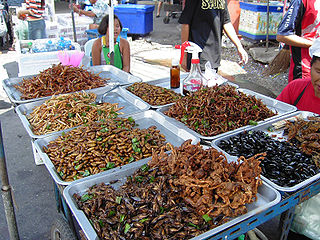Kashrut is a set of Jewish religious dietary laws. Food that may be consumed according to halakha is deemed kosher, from the Ashkenazi pronunciation of the Hebrew term kashér, meaning "fit".

Vegetarianism is the practice of abstaining from the consumption of meat, and may also include abstention from by-products of animals processed for food.
Islamic jurisprudence specifies which foods are halāl and which are harām. This is derived from commandments found in the Qur'an, the holy book of Islam, as well as the Hadith and Sunnah, libraries cataloging things the Islamic prophet Muhammad is reported to have said and done. Extensions of these rulings are issued, as fatwas, by mujtahids, with varying degrees of strictness, but they are not always widely held to be authoritative.
In computing, type introspection is the ability of a program to examine the type or properties of an object at runtime. Some programming languages possess this capability.

Entomophagy describes the practice of eating insects by humans.
Christian vegetarianism is the practice of keeping to a vegetarian lifestyle for reasons connected to or derived from the Christian faith. The three primary reasons are spiritual, nutritional, and ethical. The ethical reasons may include a concern for God's creation or a concern for animal welfare. Likewise, Christian veganism is the abstaining from the use of all animal products for reasons connected to or derived from the Christian faith.

Maceration is a bone preparation technique whereby a clean skeleton is obtained from a vertebrate carcass by leaving it to decompose inside a closed container at near-constant temperature. This may be done as part of a forensic investigation, as a recovered body is too badly decomposed for a meaningful autopsy, but with enough flesh or skin remaining as to obscure macroscopically visible evidence, such as cut-marks. In most cases, maceration is done on the carcass of an animal for educational purposes.
Religious restrictions on the consumption of pork are common particularly in the Middle East amongst Jews and Muslims. Swine were prohibited in ancient Syria and Phoenicia, and the pig and its flesh represented a taboo observed, Strabo noted, at Comana in Pontus. A lost poem of Hermesianax, reported centuries later by the traveller Pausanias, reported an etiological myth of Attis destroyed by a supernatural boar to account for the fact that "in consequence of these events the Galatians who inhabit Pessinous do not touch pork". Concerning Abrahamic religions, clear restrictions exist in Jewish dietary laws (Kashrut) and in Islamic dietary laws (Halal).

Paul Shapiro is the author of Clean Meat: How Growing Meat Without Animals Will Revolutionize Dinner and the World. He’s also the CEO and cofounder of The Better Meat Co. and the co-host of the Business for Good Podcast. Prior to publishing Clean Meat, he was known for being an animal protection advocate, both as the founder of Compassion Over Killing (COK) and a Vice President at the Humane Society of the United States (HSUS). Shapiro states that he turned to veganism in 1993.
Jhatka, or Chatka, is the meat from an animal killed instantaneously, such as by a single strike of a sword or axe to sever the head. The animal must not be scared or shaken in any way before the slaughter.

Dermestes maculatus is a species of beetle with a worldwide distribution, being present on all continents except Antarctica. In Europe, it is present in all countries.
Ray "Bones"Bandar (1927-2017) was a scientist, researcher, teacher, naturalist, and artist living in the San Francisco, California area. He had collected more than 7,000 bone specimens, primarily skulls, from animals across the world. He was legally authorized to gather specimens under the permits of the California Academy of Sciences and his collection is eventually to be inherited by the Academy.

Skulls Unlimited International, Inc. is a commercial supplier of osteological specimens located in Oklahoma City, Oklahoma. Skulls Unlimited Inc. provides a skull cleaning service, using dermestid beetles to strip the flesh from skulls and skeletons. The bones are later whitened using hydrogen peroxide. Skulls Unlimited processes approximately 25,000 skull specimens per year.

The practice of eating live seafood, such as fish, crab, oyster, young shrimp, or young octopus.

Eating live animals is the practice of humans eating animals that are still alive. It is a traditional practice in many Asian food cultures. Eating live animals, or parts of live animals, may be unlawful in certain jurisdictions under animal cruelty laws. Religious prohibitions on the eating of live animals by humans are also present in various world religions. Animals are also eaten alive for shock value.

The conservation and restoration of flags and banners is the process by which conservators work to preserve and restore flags and banners from future deterioration and damage. As a part of Conservation of Textiles, flag and banner conservation require the care of a skilled and well trained textile conservator, specifically trained in historical materials.
The conservation and restoration of fur objects is the preservation and protection of objects made from or containing fur. These pieces can include personal items like fur clothing or objects of cultural heritage that are housed in museums and collections. When dealing with the latter, a conservator-restorer often handles their care, whereas, for the public, professional furriers can be found in many neighborhoods.

The conservation of taxidermy is the ongoing maintenance and preservation of zoological specimens that have been mounted or stuffed for display and study. Taxidermy specimens contain a variety of organic materials, such as fur, bone, feathers, skin, and wood, as well as inorganic materials, such as burlap, glass, and foam. Due to their composite nature, taxidermy specimens require special care and conservation treatments for the different materials.












